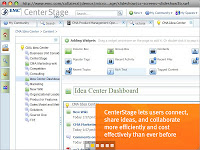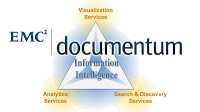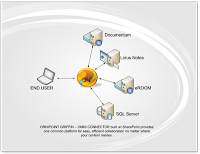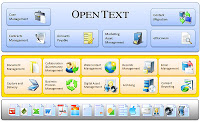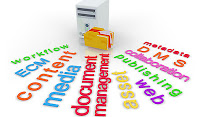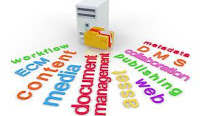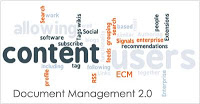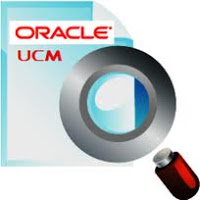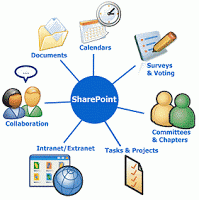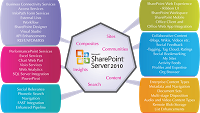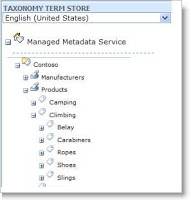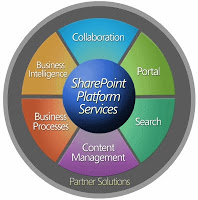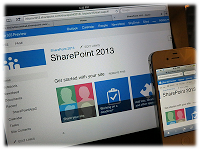Content Management Systems Reviews
Confluence means "a coming together" and has been helping workers do just that since 2004. Starting out as an enterprise wiki, it has evolved through the years into an all-round collaboration tool. Confluence is available as a SaaS or hosted product, powered by Java. It is the Atlassian product and it is designed to work with other Atlassian products.
Confluence has the widest spread application of Atlassian's products, it could be applied in almost any environment. It is free to open source institutions and non-profits. Pricing starts at just a charity donation of US$ 10 for hosted smaller installations for less than 10 users.
Content Management Systems Review - Open Text - ECM Suite - Records Management and Archiving
In my last post on Open Text ECM Suite Content Lifecycle Management group of products, I mentioned that this group consists of document management, imaging, records management, and archiving. I described document management in my previous post and I described imaging solution yesterday.
Today, I am going to describe records management and archiving solutions of Content Lifecycle Management group of products.
Records Management
OpenText Records Management (formerly Livelink ECM - Records Management) delivers records management functions and capabilities to provide full lifecycle document and records management for the entire organization. This product allows your organization to file all corporate holdings according to the organizational policies, thereby ensuring regulatory compliance and reducing the risks associated with audit and litigation. Records management can manage content in a number of different repositories.
Content Management Systems Reviews - Alfresco
In my post about open source content management systems (CMS), I mentioned that Alfresco, Drupal, Joomla, Apache Jackrabbit, Liferay are just few of the open source CMS. In this post, I will describe Alfresco which is very popular CMS.
Alfresco is an enterprise content management system for Microsoft Windows and Unix like operating systems. There are two types of Alfresco: Alfresco Community Edition and Alfresco Enterprise Edition. Alfresco Community Edition is free software. Alfresco Enterprise Edition is commercially and proprietary licensed open source for an enterprise. Its design is geared towards users who require a high degree of modularity and scalable performance.
It includes a content repository, an out-of-the-box web portal framework for managing and using standard portal content, a CIFS interface that provides file system compatibility on Microsoft Windows and Unix like operating systems, a web content management system capable of virtualizing webapps and static sites via Apache Tomcat, Lucene indexing, and Activiti workflow. The Alfresco modular architecture is developed using Java technology.
Content Management Systems Reviews - Documentum - Automatic Classification
Documentum has two tools for automatic classification: Content Intelligence Services (CIS) and EMC Captiva Dispatcher. The subject of my today’s post is Content Intelligence Services (CIS. In my next post, I will describe EMC Captiva Dispatcher.
Content Intelligence Services (CIS) is an extension to the EMC Documentum content management platform that enables automatic classification and categorization of content in the Documentum repository. Its benefit is well organized, classified, and categorized content. With CIS, content is parsed and analyzed and classification rules are applied. The results of the classification can then be used for categorization as keywords to populate content metadata.
Content Management Systems Reviews - Documentum - Automatic Classification - Captiva Dispatcher
In my last post, I mentioned that Documentum has two tools for automatic classification: Content Intelligence Services (CIS) and EMC Captiva Dispatcher. I also described Content Intelligence Services (CIS) tool. In this my post, I am going to describe EMC Captiva Dispatcher.
EMC Captiva Dispatcher delivers high speed automatic content classification, data extraction, and routing documents. With Dispatcher, companies are able to scan multiple batches of structured, semi-structured, and unstructured content within a single flow, without a need for separator sheets, barcodes, or patch codes. By combining EMC Captiva Dispatcher with the Captiva InputAsset Intelligent enterprise capture platform, you can scan, classify, extract, and deliver data from almost any kind of electronic or paper document, often without a need for manual sorting or data entry.
The result is cost reduction and business process optimization which are measures that can help save time and money while increasing an ability to manage the flow of incoming documents.
Content Management Systems Reviews - Documentum - CenterStage
In my last post on Documentum, I described one of its collaboration products - eRoom. In today's post, I am going to describe another collaboration product of Documentum - CenterStage.
CenterStage delivers the benefits of enterprise content management, advanced search, and collaboration tools on a single architecture.
It allows to:
It allows to:
- manage and visually organize project, team, and corporate work information;
- launch projects with space and content templates;
- work with team members on documents in public and private workspaces;
- find information wherever it resides;
- gain access to this information from anywhere.
Content Management Systems Reviews - Documentum - Compliance Manager
Controlled content often exists as combination of paper documents, collected in binders and distributed manually and electronic files routed for editing and approval using email. Paper documents are a burden to store, even more difficult to share widely, and they can quickly can become obsolete. Electronic content reduces the storage and distribution problem but as emails circulate their attachments may be revised resulting in different versions in use across an organization.
EMC Documentum Compliance Manager offers an automated, integrated online environment for creating, reviewing, revising, approving, distributing, and auditing controlled content.
Compliance Manager helps companies to achieve compliance with external regulations such as FDA 21 CFR Part 11 and internal policies while maintaining high product and service quality standards. It replaces unreliable and inefficient processes with streamlined processes for review, approval, and distribution, and thus reducing the time and effort employees managing controlled content.
By helping organizations meet quality objectives and comply with internal and external regulations and standards, Compliance Manager can help you to reduce operating costs, minimize waste, errors, and production delays and deliver products to market faster with greater confidence.
Content Management Systems Reviews - Documentum - Content Management Platform
Documentum is a content management system produced by EMC Corporation. It is the unified platform for storing a virtually unlimited range of content types within a shared repository. It allows to manage all types of content including documents, photos, video, images, e-mail, web pages, XML-tagged documents, etc.
The core of Documentum is a repository in which the content is stored securely under compliance rules. This repository appears as a unified environment, although content may reside on multiple servers and physical storage devices within a distributed environment.
Documentum provides a suite of services which include content management, web content management, digital asset management, collaboration, content classification, email management, input management, business solutions (forms, invoices, reports, etc.), Information Rights Management, records management, document control, archiving, etc. It also includes xml content repository component which allows dynamic publishing.
Content Management Systems Reviews - Documentum - Content Transformation Services
In my last post on Documentum, I described Digital Asset Manager and mentioned that Content Transformation Services product of Documentum is very useful in conjunction with Digital Asset Manager. Content Transformation Services product of Documentum is useful also for other content management goals. In this post, I am going to describe Documentum Content Transformation Services (CTS).
Content is typically authored in one formal (such as Microsoft Word) then converted or transformed into a different format (such as HTML or PDF) that is more appropriate for the content reuse. This is a slow process and requires specialized knowledge not possessed by every user. Documentum CTS automates the creation of re-use ready content through pre-defined format transformations that can occur on demand or systematically.
The CTS suite enhances these processes and improves efficiencies by providing additional content intelligence, such as thumbnail and storyboard support, while shielding business users from the technical complexities of converting files from one format to another.
Content Management Systems Reviews - Documentum - Digital Asset Manager
I started to describe Documentum in my last post. I described Enterprise Content Management Platform and Documentum Webtop. The subject of my today's post is Documentum Digital Asset Manager.
Documentum Digital Asset Manager (DAM) allows to manage all digital assets, rich media, and traditional documents in one interface. It provides enhanced capabilities to effectively manage rich media in addition to the complete set of enterprise content management capabilities.
DAM is a part of a total Documentum Enterprise Content Management Platform. It can be used to:
- implement rapid changes to digital assets while maintaining consistency and control;
- repurpose rich media regardless of platform or file format;
- perform fast search, retrieval, and delivery of digital assets;
- deliver enhanced media handling capabilities to your organization.
Content Management Systems Reviews - Documentum - Documentum for SharePoint
Documentum has few products for SharePoint users. These products are: Documentum Repository Services for SharePoint, My Documentum for SharePoint, Documentum SourceOne for SharePoint. In this post, I am going to describe these products.
Documentum Repository Services for SharePoint
Documentum Repository Services for SharePoint allows organizations to manage SharePoint Content and leverage it by re-routing content automatically to the EMC Documentum repository. Repository Services for SharePoint aggregates content from disparate SharePoint sites, providing centralized management and the ability to apply compliance, business, and operational control to SharePoint content without impacting the end user. SharePoint does not show that content is being managed by Documentum and SharePoint users and tools are not affected.
Content Management Systems Reviews - Documentum - eRoom
Collaboration has become very important in a work place. It increases efficiency and productivity of employees. Documentum eRoom is one of collaboration tools available on the market.
It is a web-based shared workspace where team members can store project content, communicate and share ideas, assign task, and manage deliverables using a shared project context. It improves knowledge sharing, decision making, and problem solving.. eRoom integrates well with Microsoft Office, Microsoft Project, and other desktop applications. Files can be imported from Microsoft Project into eRoom.
Content Management Systems Reviews - Documentum - Federated Search
Documentum Federated Search is a suite of products designed to solve the problem of finding information quickly. Federated Search Services is comprised of two server-based components, the Federated Search Server and Federated Search Adapter Packs, and two client-level options – Webtop Federated Search and Discovery Manager. These options enable organizations to quickly search for information stored in a myriad of sources and data formats.
Federated Search Server
Federated Search Server manages federated searches through a query broker and source adapters to provide relevant results in real time while leveraging the local index and security permissions of each source being queried. The result: the most relevant and secure real-time search results which are organized in an intuitive manner.
Content Management Systems Reviews - Documentum - Records Management
EMC Documentum Record Management Solution helps organizations to comply with legal and regulatory requirements for documents retention. This solution allows to capture and manage records generated in the company allowing for its automation. It also expands classic records management with features that track and dispose of non-records in order to reduce discovery costs and mitigate legal risks.
Records management solution is fully unified with Documentum content management platform.
Key Benefits
Risk Mitigation – reduce your content liability by disposing of records and non-records once they fulfilled all legal and regulatory and compliance obligations.
Content Management Systems Reviews - Documentum - XML Platform for Content Reuse
Designed for content oriented applications such as publishing, archiving, information mashups, regulatory filings, collaboration and knowledge management, XDB provides a scalable architecture to warehouse content in an application-neutral format, not dependent on any application for information retrieval.
XML-based Documentum platform reduces costs by enabling technical writers to reuse rather than reinvent content. You can:
- manage content at a granular level thus increasing the likelihood that a particular piece of content can be used without modification;
- automate the assignment of attributes to content so that writers spend less time describing content;
- leverage advanced search techniques to enable writers to easily find, reuse, and repurpose content;
- manage images and other types of rich media in a common content repository;
- separate content from structure and format, using external DTD and schemas to control the document structure;
- leverage automatic transformation and publishing capabilities to package information for different delivery channels;
- significantly reduce costs associated with localization and translation efforts on only the content that has changed.
Content Management Systems Reviews - Drupal
Drupal is a free and open-source content management system (CMS) and content management framework (CMF) written in PHP and distributed under the GNU General Public License. It is used as a back-end system for at least 1.5% of all websites worldwide ranging from personal blogs to corporate, political, and government sites. It is also used for content management and business collaboration.
he standard release of Drupal, known as Drupal core, contains basic features common to content management systems. These include user account registration and maintenance, menu management, RSS-feeds, page layout customization, and system administration. The Drupal core installation can be used as a brochureware website, a single- or multi-user blog, an Internet forum, or a community website providing for user-generated content.
Content Management Systems Reviews - FatWire
FatWire Software is web content and experience management software which powers web presence for organizations, allowing them to deliver relevant customer content, build community engagement and drive site stickiness and loyalty.
FatWire Software was a privately held company selling web content management system software. It was acquired by Oracle Corporation in 2011, and its products rolled up into Oracle's WebCenter product lines.
FatWire solutions are powered by content server, which combines complete business user control over the creation and presentation of content with a scalable architecture for dynamic content delivery and multi-site deployment.
Content Management Systems Reviews - Joomla
Joomla is a free and open source content management framework (CMF) for publishing content on the World Wide Web and intranets. It includes features such as page caching, RSS feeds, printable versions of pages, news flashes, blogs, polls, search, and support for language internationalization.
Over 9,200 free and commercial extensions are available from the official Joomla! Extension Directory, and more are available from other sources. It is estimated to be the second most used CMS on the Internet after WordPress. Joomla won the Packt Publishing Open Source Content Management System Award in 2006, 2007, and 2011.
You can think of a Joomla! website as bringing together three elements:
-
your content, which is mainly stored in a database;
-
your template, which controls the design and presentation of your content (such as fonts, colors and layout);
-
Joomla! which is the software that bring the content and the template together to produce webpages.
Content Management Systems Reviews - Open Text
Open Text Corporation is the software company which provides enterprise content management (ECM) software solutions. This software combines content lifecycle management, business processes, and collaboration. It includes the underlying platform to manage most content types, ranging from user generated content in social networks to data in enterprise resource management systems. These ECM technologies can be used to address end user engagement, business agility, and cost and risk reduction.
Open Text sells software licenses including support and maintenance, offers worldwide consulting services, software training, and individual support packages.
Content Management Systems Reviews - Open Text - ECM Suite
In my first post about Open Text, I mentioned that Open Text Corporation is the software company which provides enterprise content management (ECM) software solutions. I described Open Text Solutions in general. In my today's post, I am going to start describing Open Text ECM Suite.
The Open Text ECM Suite integrates multiple technologies for document management, records management, web content management, portal, digital asset management, email management, and content lifecycle management. Other components include electronic discovery, auto-classification, document capture, document imaging and digital faxing solutions. The suite provides functions for team collaboration, forums, blogs, wikis, and real-time instant messaging and collaboration. These functions are connected through business process management tools to each other and to other business applications and processes.
Content Management Systems Reviews - Open Text - ECM Suite - Auto Classification
For records managers and others responsible for building and enforcing classification policies, retention schedules, and other aspects of records management plan, the problem with traditional, manual classification methods can be overwhelming.
Content needs to be classified or understood in order to determine why it must be retained, how long it must be retained, and when it can be dispositioned. Managing the retention and disposition of information reduces litigation risk, reduces discovery and storage costs, and ensures that organizations maintain regulatory compliance.
Classification is the last thing end-users want (or are able) to do. Users see the process of sorting records from transient content as intrusive, complex, and counterproductive. On top of this, the popularity of mobile devices and social media applications has effectively fragmented the content authoring market and has eliminated any chance of building consistent classification tools into end-user applications.
Content Management Systems Reviews - Open Text - ECM Suite - Content Lifecycle Management
In my last post about Open Text, I started describing Open Text ECM Suite. The subject of my today's post is Open Text ECM Suite - Content Lifecycle Management. Content Lifecycle Management includes document management, imaging, records management, and archiving.
Managing, controlling, and securing content is critical to an organization’s overall information governance strategy. OpenText ECM Suite, Content Lifecycle Management gives organizations ECM solutions to manage content throughout its entire lifecycle.
Features
Fully featured, highly scalable, web-based document management provides a secure, single repository for organizing and sharing enterprise content.
Workflow automates processes, such as change requests and approval, for accuracy and consistency. Processes can be designed according to corporate or regulatory standards.
Content Management Systems Reviews - Open Text - ECM Suite - Document Management
Open Text ECM Suite - Document Management (formerly Livelink ECM - Document Management) is a document management solution that provides full lifecycle management for any type of electronic document. Document Management provides a single, authoritative repository for storing and organizing electronic documents. Web based interface and open architecture make it easy to deploy.
It is the powerful, fully integrated content management system that delivers the essential capabilities for managing documents. You can store, organize, access, and manage documents in an organized, hierarchical structure. Version control and audit trail functions ensure accuracy and currency. Powerful search functionality allows users to easily find what they need when they need it. Classification and metadata identify content authors and stakeholders so users can quickly find subject matter experts.
Documents from across entire organization can be consolidated within a centralized web-based interface. Each user has access to a personal workspace which can be customized to suit individual preferences and enhance the overall user experience. By allowing users to organize information intuitively, they can quickly access what they need.
Content Management Systems Reviews - Open Text - ECM Suite - Knowledge Management
OpenText Knowledge Management (formerly Livelink ECM - Knowledge Management) is a comprehensive knowledge management solution that enables organizations to search, classify, navigate, and collect all of their corporate knowledge in a single, secure, web based repository.
OpenText Knowledge Management works with OpenText Document Management or OpenText Content Lifecycle Management, leveraging the power of these content repositories and adding functionality that manages all knowledge from a single interface, regardless of originating source. Open Text Knowledge Management is a completely integrated, web based solution that delivers end-to-end, closed-loop management for all of your corporate knowledge assets.
Knowledge Management enables employees to perform their daily work more efficiently and accurately. The benefits of a centralized knowledge repository and library services ensures that you are working with the most up-to-date information. Specialized tools enable you to identify topic experts; quickly finding the best information resources from anywhere in your organization.
Content Management Systems Reviews - Open Text - ECM Suite - Portal
OpenText Portal (formerly Vignette Portal) is a part of OpenText ECM Web Content Management Solution. It enables you to create web sites with rich content and applications, enabling customized users interactions. It provides a highly scalable and efficient means of aggregating content and applications for use across a variety of initiatives inside and outside the firewall.
It enables users to combine web services, repository data, and user interfaces in meaningful ways to create valuable business applications without IT help. Users can create web pages by simply selecting portlets from OpenText’s library of over 200 portlets.
Portal layout management allows users to easily apply a variety of page layouts via visually intuitive tools. There is interaction between portlets. Pages refresh only as needed. Portlets load separately, so the end user does not have to wait until the entire page loads. Pages are dynamic and load quickly.
Content Management Systems Reviews - Open Text - ECM Suite - Web Content Management
The following products deliver the Web Content Management component of the OpenText ECM Suite:
OpenText Web Experience Managementis a comprehensive solution for managing content in high performance, scalability, and transaction-oriented web applications.
OpenText Portalworks in tandem with OpenText Web Experience Management to allow you to rapidly create mashups and composite applications built on Web services, repository data, and user interfaces.
OpenText Dynamic Portalfor Third-Party Portals works in tandem with OpenText Web Experience Management to allow you to publish content directly into portals such as Liferay, IBM WebSphere, or Oracle WebCenter.
Content Management Systems Reviews - Oracle UCM
Oracle Universal Content Management (UCM), formerly Stellent, is a component CMS and supports the entire content lifecycle. Component CMS manages content at a component level rather than at the document level.
Oracle UCM manages the entire spectrum of unstructured content - from documents, graphics, and Web pages to scanned images, e-mail, and records.
Oracle UCM converts over 500 file formats to web-ready formats such as HTML, XML, GIF and PDF, and delivers content via web sites, desktops, syndication feeds, mobile devices, and web services.
It integrates with Microsoft Office, Outlook, AutoCAD, Lotus Notes. It includes multi-site web content management, document and image management, digital asset management, records and retention management, personalized content delivery, categorization, portal integration, SharePoint integration, document capture and scanning integration, content conversion and transformation.
Content Management Systems Reviews - SDL Tridion
SDL Tridion is the leading web content management system. This solution enables organisations to deliver a consistent, interactive and highly targeted customer experience, in multiple languages, across multiple web sites and channels including email, mobile sites and print.
In addition to content creation, management, translation, delivery and archiving solutions, SDL Tridion provides brand management, targeted communication, multi-channel delivery and visitor interaction capabilities.
Content Management Systems Reviews - Sharepoint
First launched in 2001, Microsoft SharePoint is typically associated with content a management system, but it is actually a much broader platform of web technologies, capable of being configured into a wide range of solution areas.
SharePoint is designed as a broad, central application platform for multiple purpose. SharePoint's multi-purpose design allows for managing of intranet portals, extranets, websites, document management, collaboration spaces, social tools, enterprise search, business intelligence, project management, workflow automation, and core infrastructure for third-party solutions.
Content Management Systems Reviews - TeamSite
In my previous posts, I described component content management. A component content management system (CCMS) is used for managing component content.
A component content management system (CCMS) is a content management system that manages content at a granular or component level rather than at the document level. There are few of them in today's market including Interwoven, Documentum, AuthorIT, DocZone, Vasont, SiberLogic, Trisoft, Astoria, Tridion. In this my post, I am going to describe Interwoven.
This system is made by Interwoven company which was purchased by Autonomy which in turn was purchased by HP. Autonomy TeamSite is a market-leading content management system for content authoring, site design and layout, content targeting, advanced analytics, workflows, and archiving.
Interwoven TeamSite® is the industry’s most advanced Web Content Management System. For enterprises, TeamSite powers corporate and ecommerce web sites, employee intranets, support portals, marketing microsites, and extranets as well as e-mail, wireless, and print.
SharePoint 2010 - Part 1
Today, I am going to describe more details about SharePoint 2010.
New user interface
SharePoint 2010 user interface includes a new ribbon to perform tasks quickly and in the context of your work. If you work with 2007 Microsoft Office applications such as Microsoft Word or Microsoft PowerPoint, you are already familiar with the ribbon.
Like the ribbon in these Office applications, the new ribbon in SharePoint 2010 is designed to help you quickly find the commands that you need to complete your tasks. Commands are organized in logical groups, displayed together under tabs. Each tab relates to a type of activity, such as working with a document in a document library or adding and formatting text on a page.
SharePoint 2010 - Part 2
SharePoint 2010 - What is different?
My last post was about Microsoft SharePoint. Today, I am going to talk about the differences in SharePoint 2010.
SharePoint Editions
Microsoft SharePoint 2010 comes in three different editions: SharePoint Foundation, SharePoint Standard, and SharePoint Enterprise.
Microsoft SharePoint Foundation
Microsoft SharePoint Foundation is the platform for all products in the SharePoint family. It contains all of the core functionality and architecture drawn on by the commercial versions of the package. SharePoint Foundation is available for download at no cost. Downloading SharePoint Foundation however, requires a mandatory registration.
SharePoint 2013 - Adopt it or Not?
You may have just finished with upgrading your SharePoint to 2010 version and now we are hearing about SharePoint 2013. What is this all about? And are you going to adopt it or not?
Microsoft releases a major version of SharePoint every three years. SharePoint 2013 is a significant release with many new great features. However, you may find it hard to justify moving on to 2013 release in the near future, unless you can find a business justification for spending the time and money it will take to make the transition.
I am going to highlight new features of SharePoint 2013 to help you with this decision.
Reuse Content Across Multiple Sites
One of the pain points experienced in previous versions of SharePoint was around the fact that content that was created within one site collection could not easily be reused in a separate site collection. Since many organizations required multiple site collections, this limitation created a few cases where duplicate content was required.










